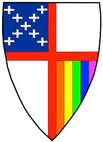|
The earliest recording of a Palm Sunday parade (besides the Gospels of course) is from a Spanish woman named Egeria, who journaled about her pilgrimage to Jerusalem in the 4th Century.
This journal speaks of the liturgical traditions, and her travels, and importantly about a woman traveling in the 300s. Making a pilgrimage to Jerusalem was an important part of Christian custom (and continues to be for the Jewish community as well.) She was a representative from her community, as so many could not - and still cannot afford to make such a trip. The Labyrinth walk that you may have heard of, which looks somewhat like a maze is a circular walk designed to imitate the pilgrimage. Labyrinths are found in Cathedral floors - and now much more commonly in retreat centers. When you walk the labyrinth, rather than finding oneself at a possible dead-end like a maze, the labyrinth is a circle that spirals around to the center. It is designed to wind one into center, at one time to the center of God, initially to Jerusalem, and to the center of self; the heart of a spiritual journey where we connect to God. On Palm Sunday, Jesus was spiraling into the center of God in his parade. It was taking him directly into the heart of Jerusalem. It was the festival of the passover and the city was jam packed with a population five times its normal size with pilgrims flooding the streets, living in camps. It was chaotic.
At the same time Jesus was making that pilgrimage through the midst of fear and into a certain fate that he knew awaited him. Jesus had said earlier to [his disciples], “You will all become deserters; for it is written, ‘I will strike the shepherd, and the sheep will be scattered.’
Saying things like the Sabbath was made for the people…not the other way around. Healing may happen seven days a week. Today the Litany of the Palms reminds us of the Glory of God: Our hope in a the reign of God, our hope in a peaceful transfer of power, in a kingdom of justice and truth, in a messiah full of wisdom and humility. -- The Gospel reading feels like whiplash to our celebration in so many ways winding us through the awful events of Good Friday. It is read as a great juxtaposition to this Hope that fueled the hearts of Jesus’ followers. The Passion is incredibly painful to read. It is devastating all around. Jesus is utterly abandoned by his friends. They fall sleep instead of keeping watch, they run to escape (even to the point of losing their shirts), they deny instead of ally. It shows us what Fear does to us - and to the World… It shows us all of our human trespasses… Where Greed and jealousy take us - Where indifference - and desire for control lead us. The story shows us these temptations in all echelons of society (even in a servant girl) - in both the Roman and Jewish population - even in Jesus’ closest friends. The Passion is in all four gospels… And the crowd that rise up to shout “crucify him” is not very well defined in any of them. I wonder why? We cannot point the finger directly at any one person or group for the atrocities of this day. It asks us to look closely at our Christian identity. Not to point fingers, but to consider how we individually act out these patterns - of both trespasses and healing. The spiritual journey asks us to make this pilgrimage to God in our hearts - and often we find that also requires moving through fear, into the chaos of the unknown. It is a path of surrender to something much greater than ourselves. The spiritual journey is a surrender to Love. Cynthia Bourgeault writes: “When the attitude of prompt surrender has become permanently engrained in a person… that person becomes a powerful servant of humanity—a saint, in the language of the Christian West—whose very being radiates blessing and spiritual strength.” How do we follow Jesus into this way of powerful spiritual surrender? Paradoxically the path of surrender to God - (to something so much bigger than ourselves) in order to be transformed - means to surrender to quite little things for the sake of others. And this is when we actually realize how little some of our hang ups really are, how trivial… and when we practice becoming softer and more open - we are not being weak - we are glorifying the presence of one another and God. As Iraneous of Lyons said, “the Glory of God is the person fully alive.” Meaning: The Glory of God gives life. It is an attention we are gathering when we attempt to do this for God, for one another, and ourselves. We are pilgrimaging to that center of God in our hearts. Jesus models for us in his triumphant entry that it requires holding that space for both celebration and humility in order for something new to come forth. John the Baptist said about Jesus…. “I must decrease so that he may increase.” Jesus in his surrender was actively glorifying God in his decrease. This decrease is so counter-cultural. But the end of our Gospel passion shows us that God identifies with the victim, the poor, and the marginalized: the scapegoat. The centurion exclaims: He really was the “Son of God.” __ As Christians we follow Christ into this message by surrendering to God’s truth - that the Spirit of healing and Love is alive in us as “servants of humanity.” The passion asks us to lay down our lives for this healing message seven days a week. Amen.
0 Comments
Leave a Reply. |
AuthorThe Rev. Heather K. Sisk Archives
July 2024
Categories |
We Would Love to Have You Visit Soon!
WE ARE ALL MADE IN THE IMAGE OF GOD |
Telephone845-635-2854
|
|
 RSS Feed
RSS Feed

